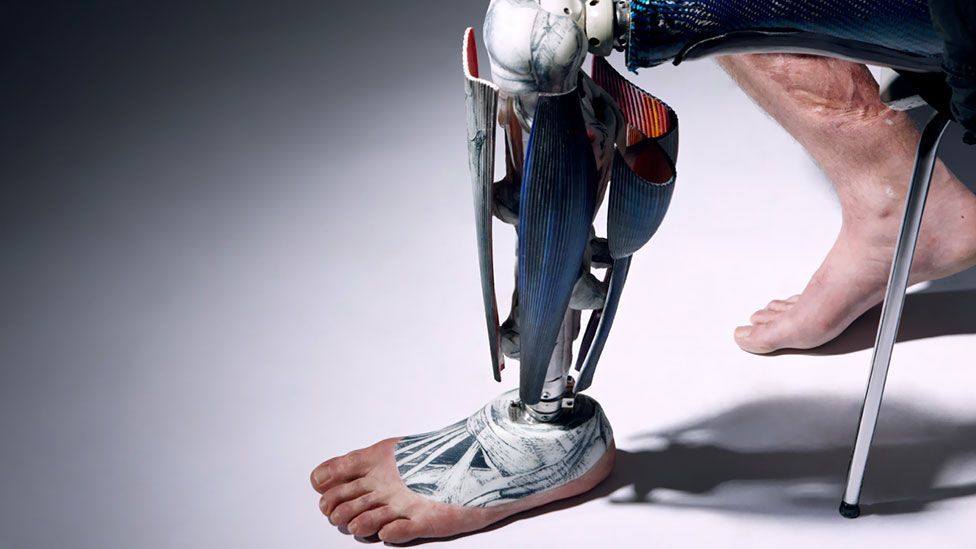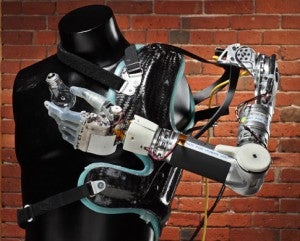 Beyond bionics: how the future of prosthetics is redefining humanity | by David Alayón | Future Today | Medium
Beyond bionics: how the future of prosthetics is redefining humanity | by David Alayón | Future Today | MediumHealth news The future of prosthesis could be in this mind-controlled bionic arm For the past 7 years, researchers in Sweden have been studying a new type of mind-controlled prosthesis arm that could dramatically improve the lives of people who have lost a member. The prosthesis of the arm is implanted through a process called osseointegration, in which the prosthesis is surgically connected to the bone, muscles and nerves. The technology involves implanting electrodes that collect the signals from the brain and allows people to move, feel and use the new limb in an intuitive and natural way. A new published in the New England Journal of Medicine on Thursday evaluated the effectiveness of the new prosthesis and found that it could be successfully used on a daily basis in a variety of personal and professional activities. Development is a great victory for the amputated, who have long been stuck with limited prosthesis options. Conventional prostheses usually need to be succionated to a person's extremity through a tight compression cup. Many amplifiers find, causing many to stop using their prosthesis. "The osseointegrated implants of Sweden are quite amazing and have made the use of a prosthesis much more tolerable because it overcomes the discomfort of the compression cup that most users have to use with traditional and mioelectric prosthesis," said a plastic and reconstructive surgeon and specialist in superior limbs of Yale Medicine. Researchers from Sweden followed four people who received osseointegrated mind-controlled implants for 3 to 7 years. According to the principal researcher of the study, , PhD, associate professor at the University of Technology of Chalmers, this is the first time that a bionic arm that works outside the implanted electrodes was used independently by people at home, so there were a number of questions about the long-term stability and functionality of the prosthesis. The technology had been studied extensively in the laboratory, but the researchers wanted to test them in the real world. "You still have to [check it is] safe in real life when humans use it," Catalan told Healthline. The research team found that prosthesis could be effectively used all day in the personal and professional activities of the people. "The main contribution of our work is that we have [enabled the use] of implanted electrodes to control and provide sensation in [a] prosthesis that is used by patients in their daily lives, finally out of controlled or constantly supervised environments," Catalan said. One of the participants involved in the study, a 46-year-old man named Rickard Normack who lost an arm in a work-related accident, said in a detail the new prosthesis that was never happy with his traditional sleeve pros. Finally, he received an osseointegrated prosthesis controlled by the mind and says he has changed his life for the better. "I usually say that with a traditional sleeve prosthesis, you use prosthesis — it's a medical device. But with osseointegration, the medical device becomes part of you. You don't feel like you're using prosthesis; rather, it's a part of you," Normack said. Magnus Niska, 47, also involved in the program, says he can do anything with his new prosthesis, and it feels like it's his. An implant binds into the bone of the remaining limb through the osseointegration, which essentially extends the skeleton to where the prosthesis arm can be coupled. The electrodes are then implanted in the nerves and muscles of the patient. When these electrodes collect a signal — for example, a person wants to move the finger — they feed through an artificial intelligence algorithm that tells the prosthetic member what to do: move the finger. The finger moves. Researchers from Sweden call this process "intuitive control". The beauty of this type of technology is that it is bidirectional, according to a plastic and hand reconstructive surgeon in Yale Medicine. "After the finger moves or touches something, this signal feeds back to the sensors wrapped around the nerves. The nerves receive this signal and send signals to the brain that create a 'feeling' of a realistic and immediate sense of touch," explained Prsic. "It's a real extension of the patient's limb," added Prsic. There are some types of prosthesis that are traditionally used among amputated. There is a non-functional extremity that is used simply for cosmetic purposes along with an extremity that works on a pulley and wire system. There are osointegrated limbs, but the widely available now do not have the technology operated by the mind. Myoelectric prosthesis is also used, in which a prosthesis has a custom socket that has been thrown on the residual extremity. Prsic says how the new osseointegrated limbs controlled by the mind, the myoelectric prosthesis is more or less controlled by the mind. The brain sends an electrical signal to the nerves and muscles, which is then transferred to the prosthesis. The key difference is that electrical sensors used with myoelectric prosthesis are connected to the skin from the outer plug, while the new osseointegrated prosthesis controlled by the mind has all the wiring under the skin, explains Prsic. Conventional prophetic extremities can be uncomfortable and painful. A lot of people end up leaving them. "Progress in engineering and design, with the electrical components [and] technology now more compact and efficient, has made a big difference," said Prsic. "In addition, light and robust materials have revolutionized the size and weight of the prosthesis, making it easy for even the smallest of our patients." Clune says that "it is not a matter of whether this technology will be used here [in the United States], but when." He hoped to see a more widespread use of the osseointegration prosthesis operated by the mind in the near future. However, one of the biggest obstacles in introducing advanced limbs controlled by the mind to the market is the cost, notes of Clune. The difference in cost between a body-enforced extremity and an external osseointegrated extremity are exponentially different. Therefore, there is a battle uphill to bring osseo-integrated limbs to the market here in the United States," Clune said. Already, several universities—including and— have developed and begun to test their own mind-controlled prosthesis. In Yale, a team of doctors and scientists has formed an approach to reorganizing nerves in a remaining member to help prepare it for advanced prosthesis on the way. "Even if the patient can't reach advanced prosthesis now, nerves in his limb can now be surgically prepared in preparation for the use of emerging technologies in the future," Clune said. Prsic hopes that technology will continue to advance and fill the remaining gaps in the control of prosthesis, and will be more accessible in the coming years. "It's my hope to see myoelectric technology, both osseointegrated and not, become affordable and then widely available to all who need it, and not just for those who can pay the heavy price tag," said Prsic. Researchers from Sweden have been studying a new type of mind-controlled prosthesis arm that could dramatically improve the lives of people who have lost a member. The technology used is to implant electrodes that collect the signals from the brain and allow people to move, feel and use the new limb in an intuitive and natural way; if a person wants to move a finger, the prosthetic finger moves. Development is a great victory for people who have lost a member, a population that has had limited options for prosthesis, many of which are uncomfortable and painful. Read this next series of words
Beyond Bionica: How the Future of Prosthesis Is Redefining Humanity – Video Bionic technology is eliminating the physical barriers faced by disabled people by raising deep issues of what is human being. From the DIY prosthesis made through 3D printing technology to AI-driven personalized members, science is at the forefront of many innovations that promote life , Ash Jenkins, , and , Source: guardian Tue 26 Jun 2018 08.01 BST Last modified in Tue 26 Jun 2018 14.16 BST

The Future of Prosthetics Might Be in This Mind-Controlled Bionic Arm
The Future of Prosthetics Could Be This Brain-Controlled Bionic Leg | WIRED
The amazing bionic prosthetics that are changing lives and shaping our future | TechRadar
The Future Of Prosthetics Depends On A.I. - The Medical Futurist
Neuroprosthetic Limbs: Exploring the Future of Prosthetics - Amputee Coalition
Wearing a Deus Ex-inspired bionic arm is the future of prosthetics - CNET
The future of 3D-printed prosthetics | TechCrunch
Alternative Limb Project pushes prosthetics into future
How Robotics are the Future of Artificial Limbs and What That Means for OEMs | EPTAC
The future of permanent, fully integrated prosthetic limbs and bionic implants - ExtremeTech
Beyond bionics: how the future of prosthetics is redefining humanity - YouTube
The Future of Prosthetics: The Hero Arm – The Falcon Press
The history and future of prosthetics - The Hub
Future prosthetic: towards the bionic human The Engineer
The magic touch: bringing sensory feedback to brain-controlled prosthetics - Medical Technology | Issue 11 | January 2019
Future prosthetic: towards the bionic human The Engineer
This mind-controlled arm is the future of prosthetics: 90 Seconds on The Verge - YouTube
The Future Of Touch-Sensitive Prosthetic Limbs: Real-Time Sensory Information | Science 2.0
The race towards a bionic future - Raconteur
The Future of Prosthetic Technology is Here | BOSS Magazine
Smart, made-to-order limbs are the future of prosthetics
How Bionics are Redefining the Future of Prosthetics
Young engineers propel prosthetics into the future | E&T Magazine
The Future of Prosthetics Could Be This Brain-Controlled Bionic Leg | Prosthetic leg, Prosthetics, Legs
13 Prosthetic Arms and Legs and More That Appear to have Come from the Future
The future of permanent, fully integrated prosthetic limbs and bionic implants - ExtremeTech
Somatosensory Neuroprosthetic Hands? A Look At The Past And Future Of Prosthetics
The future of artificial limbs
The Future of Prosthetics Could Be This Brain-Controlled Bionic Leg | WIRED
Prosthetics: Meet the man with 13 legs - BBC Future
6 Prosthetic-Technology Breakthroughs = Better Living Through Design
Prosthetic Limb Technological Advancements for Amputees
The Future Of Prosthetics Depends On A.I. - The Medical Futurist
Deka's Luke Arm In Clinical Trials, Is it the Future of Prosthetics? (Video)
When Will Robotic Prosthetics Become Commonplace?
The future of prosthetics is osseointegrated implants |
Beyond bionics- the future of Prosthetics | WordlessTech
Bone Implants and Prosthetics
Future prosthetic: towards the bionic human The Engineer
The future of prosthetics - two companies delivering fun and function to children who've experienced limb loss | Royds Withy King
 Beyond bionics: how the future of prosthetics is redefining humanity | by David Alayón | Future Today | Medium
Beyond bionics: how the future of prosthetics is redefining humanity | by David Alayón | Future Today | Medium




































Posting Komentar untuk "the future of prosthetics"